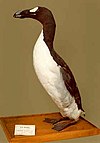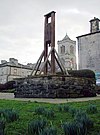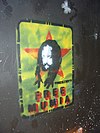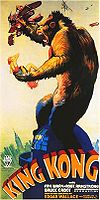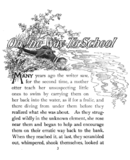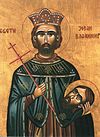Wikipedia:Today's featured article/July 2012
| << | Today's featured articles for July 2012 | >> | ||||
|---|---|---|---|---|---|---|
| Su | Mo | Tu | We | Th | Fr | Sa |
| 1 | 2 | 3 | 4 | 5 | 6 | 7 |
| 8 | 9 | 10 | 11 | 12 | 13 | 14 |
| 15 | 16 | 17 | 18 | 19 | 20 | 21 |
| 22 | 23 | 24 | 25 | 26 | 27 | 28 |
| 29 | 30 | 31 | ||||
July 1
Rwanda is a country in central and eastern Africa located a few degrees south of the Equator, bordered by Uganda, Tanzania, Burundi and the Democratic Republic of the Congo. All of Rwanda is at high elevation, with a geography dominated by mountains in the west, savanna in the east, and numerous lakes throughout the country. The climate is temperate. The predominantly rural population of 11.7 million people forms three main groups: the Hutu, Tutsi, and Twa. After Rwanda was first settled by hunter-gatherers in the Stone and Iron Ages, the population coalesced into clans and then into a Tutsi-led kingdom. It was colonised by Europeans in the 19th century and gained independence from Belgium on 1 July 1962 after a Hutu revolt led to massacres of Tutsis and the establishment of a Hutu-dominated republic. In 1990 the Tutsi-led Rwandan Patriotic Front (RPF) launched a civil war, which was followed by the 1994 Rwandan Genocide, in which Hutu extremists killed an estimated 500,000 to 1 million Tutsi and moderate Hutu but were ultimately defeated by the RPF. The economy suffered during the genocide, but has since strengthened and depends heavily on subsistence agriculture. (more...)
Recently featured: Yogo sapphire – Olivia Shakespear – Pyotr Ilyich Tchaikovsky and the Belyayev circle
July 2
The Battle of Schellenberg was fought in 1704 during the War of the Spanish Succession. The engagement was part of the Duke of Marlborough's campaign to save the Habsburg capital of Vienna from a threatened advance by King Louis XIV's Franco-Bavarian forces ranged in southern Germany. Marlborough had commenced his 250-mile (400 km) march from Bedburg, near Cologne, on 19 May. En route, the Allies needed to secure a fortified bridgehead and magazine on the Danube through which their supplies could cross to the south of the river into the heart of Bavaria. For this purpose, Marlborough selected the town of Donauwörth. Once the French knew of the Allies' objective, they dispatched Count d'Arco with an advance force of 12,000 men from their main camp at Dillingen to strengthen and hold the Schellenberg heights above the town. Rejecting a protracted siege, Marlborough decided in favour of a quick assault before the position could be made impregnable. After two failed attempts to storm the barricades the Allied commanders, acting in unison, finally managed to overwhelm the defenders. The deliberate devastation of Max Emanuel's lands in Bavaria failed to bring him to battle or persuade him back into the Grand Alliance. Only when Marshal Tallard arrived with reinforcements, and Prince Eugene of Savoy arrived from the Rhine to bolster the Allies, was the stage finally set for the decisive action at the Battle of Blenheim the following month. (more...)
Recently featured: Rwanda – Yogo sapphire – Olivia Shakespear
July 3
The Great Auk was a large, flightless alcid that became extinct in the mid-19th century. It lived in the North Atlantic, and bred on rocky, isolated islands with easy access to both the ocean and a plentiful food supply, a rarity in nature that provided only a few breeding sites for it. The Great Auk was 75 to 85 centimetres (30 to 33 in) tall and weighed around 5 kilograms (11 lb), making it the largest alcid. It had a black back and a white belly. The black beak was heavy and hooked with grooves on its surface. During summer, the Great Auk had a white patch over each eye. During winter, the auk lost this patch, instead developing a white band stretching between the eyes. The auk was a powerful swimmer, a trait that it used in hunting. Humans had hunted the Great Auk for more than 100,000 years, and by the 19th century, its growing rarity increased interest from European museums and private collectors in obtaining skins and eggs of the bird. The last two confirmed specimens were killed off the coast of Iceland on July 3, 1844. The last credible observation is from 1852. (more...)
Recently featured: Battle of Schellenberg – Rwanda – Yogo sapphire
July 4
Garret Hobart (1844–1899) was the 24th Vice President of the United States (1897–1899), serving under President William McKinley. He was the sixth American vice president to die in office. Hobart served in local governmental positions, and then successfully ran for office as a Republican, serving in both the New Jersey General Assembly and the New Jersey Senate. Hobart was a longtime party official, and New Jersey delegates went to the 1896 Republican National Convention determined to nominate the popular lawyer for vice president. Hobart's political views were similar to those of McKinley, who was the presumptive Republican presidential candidate. With New Jersey a key state in the upcoming election, McKinley and his close adviser, future senator Mark Hanna, decided to have the convention select Hobart. The vice-presidential candidate emulated his running mate with a front porch campaign, though spending much time at the campaign's New York City office. McKinley and Hobart were elected. As vice president, Hobart proved a popular figure in Washington and was a close adviser to McKinley. Hobart's tact and good humor were valuable to the President. Hobart died in November 1899 of heart disease at age 55; his place on the Republican ticket in 1900 was taken by New York Governor Theodore Roosevelt. (more...)
Recently featured: Great Auk – Battle of Schellenberg – Rwanda
July 5
Hygeberht was the Bishop of Lichfield from 779 and Archbishop of Lichfield after the elevation of Lichfield to an archdiocese some time after 787, during the reign of the powerful Mercian king Offa. Little is known of Hygeberht's background, although he was probably a native of Mercia. Offa succeeded in having Lichfield elevated to an archbishopric, but the rise in Lichfield's status was unpopular with Canterbury, the other southern English archbishopric. Offa was probably motivated by a desire to increase the status of his kingdom and to free his kingdom's ecclesiastical affairs from the control of another kingdom's archbishopric, and possibly the need to secure the coronation of Offa's successor, which the Archbishop of Canterbury had opposed. After Offa's death his distant relative Coenwulf became king, and petitioned the pope to have Lichfield returned to a simple bishopric. The pope agreed to do so in 803, by which time Hygeberht was no longer even considered a bishop: he is listed as an abbot at the council that oversaw the demotion of Lichfield in 803. The date of his death is unknown. (more...)
Recently featured: Garret Hobart – Great Auk – Battle of Schellenberg
July 6
The Calgary Stampede is an annual rodeo, exhibition and festival held every July in Calgary, Canada. The ten-day event attracts over one million visitors per year and features a parade, midway, stage shows, concerts, agricultural competitions, chuckwagon racing and First Nations exhibitions. The first Stampede was held in 1912, organized by American promoter Guy Weadick and supported by four area ranchers as a celebration of their lifestyle. A second Stampede was held in 1919 and it became an annual event in 1923 when it merged with the Calgary Industrial Exhibition. It is one of Canada's largest festivals and has become synonymous with Calgary's identity. It is a significant tourist attraction for the city which takes on a party atmosphere: businesses decorate their buildings in cowboy and western themes and hundreds of community events are held throughout the city. The Stampede is one of the premier events on the professional rodeo and chuckwagon circuits. Both are televised nationally in Canada and offer one of the largest prize funds in each sport. Some events, particularly chuckwagon racing, are controversial and have become the target of international criticism by animal welfare groups. (more...)
Recently featured: Hygeberht – Garret Hobart – Great Auk
July 7
Killer7 is an action-adventure video game developed by Grasshopper Manufacture and published by Capcom. Suda51 wrote and directed the game, his first to be released outside Japan on July 7, 2005. Killer7 features first-person shooter elements and a unique "on rails" control scheme, but the core adventure-style gameplay has been compared to Myst and Snatcher. The game follows an elite group of assassins called the "killer7". The assassins, physical manifestations of one man Harman Smith, perform hits on behalf of the United States government. Through these missions, the killer7 uncover a deeper conspiracy regarding the role of Japan in US politics and secrets about the nature of their organization. The game received polarized reviews due to its unconventional control scheme and complex noir plot. Jack Thompson, an outspoken video game activist, alleged that the game contains "full-blown sex sequences", but his claims were ultimately refuted. Despite these setbacks, Killer7's cult appeal led to remakes of Suda51's older works and the successful launch of No More Heroes. (more...)
Recently featured: Calgary Stampede – Hygeberht – Garret Hobart
July 8
Dendrocollybia is a genus of fungus in the family Tricholomataceae of the order Agaricales. It consists of the single species Dendrocollybia racemosa, a somewhat rare fungus found in the Northern Hemisphere, including the Pacific Northwest region of western North America, and Europe. It usually grows on the decaying fruit bodies of other agarics—such as Lactarius and Russula—although the host mushrooms may be decayed to the point of being difficult to recognize. Dendrocollybia racemosa fruit bodies have small pale grayish-white or grayish-brown caps and thin stems. The species is characterized by its unusual stem, which is covered with short lateral branches. The branches often produce spherical slimeheads of translucent conidiophores on their swollen tips. The conidiophores produce conidia (asexual spores) by mitosis. Because the fungus can rely on either sexual or asexual modes of reproduction, fruit bodies sometimes have reduced or even missing caps. The unusual stems originate from black pea-sized structures called sclerotia. It can reproduce at relatively low temperatures, an adaptation believed to improve its ability to grow quickly and fruit on decomposing mushrooms. (more...)
Recently featured: Killer7 – Calgary Stampede – Hygeberht
July 9
The Cross of Gold speech was delivered by William Jennings Bryan, a former congressman from Nebraska, at the Democratic National Convention in Chicago on July 9, 1896. In the address, Bryan supported bimetallism or "free silver", which he believed would bring the nation prosperity. He decried the gold standard, concluding the speech, "you shall not crucify mankind upon a cross of gold". Bryan's address helped catapult him to the Democratic Party's presidential nomination; it is considered one of the greatest political speeches in American history. For twenty years, Americans had been bitterly divided over the nation's monetary standard. Many Americans believed bimetallism (making both gold and silver legal tender) was necessary to the nation's economic health. Bryan's speech, delivered at the close of the debate on the party platform, electrified the convention and is generally credited with getting him the nomination for president. However, he lost the general election to William McKinley and the United States formally adopted the gold standard in 1900. (more...)
Recently featured: Dendrocollybia – Killer7 – Calgary Stampede
July 10
The Halifax Gibbet was an early guillotine, or decapitating machine, used in the town of Halifax, West Yorkshire, England. It was probably installed some time during the 16th century as an alternative to beheading by axe or sword. Halifax was once part of the Manor of Wakefield, where ancient custom and law gave the Lord of the Manor the authority to execute summarily by decapitation any thief caught with stolen goods to the value of 13½ pence or more, or who confessed to having stolen goods of at least that value. The device consisted of an axe head fitted to the base of a heavy wooden block that ran in grooves between two 15-foot (4.6 m) tall uprights, mounted on a stone base about 4 feet (1.2 m) high. A rope attached to the block ran over a pulley, allowing it to be raised, after which the rope was secured by attaching it to a pin in the base. The block carrying the axe was then released either by withdrawing the pin or by cutting the rope once the victim was in place. The date of the gibbet's installation is uncertain, so it cannot be determined with any accuracy how many were executed using the Halifax Gibbet. By 1650, public opinion considered beheading to be an overly severe punishment for petty theft; use of the gibbet was forbidden by Oliver Cromwell, and the structure was dismantled. The stone base was rediscovered and preserved in about 1840, and a non-working replica was erected on the site in 1974. (more...)
Recently featured: Cross of Gold speech – Dendrocollybia – Killer7
July 11
Mumia Abu-Jamal (born 1954) is an American convict, serving a life sentence for the 1981 murder of Philadelphia police officer Daniel Faulkner. He was sentenced to death at his first trial in July 1982, and his case became an international cause célèbre. Before his arrest, he was an activist and radio journalist who became President of the Philadelphia Association of Black Journalists. He was a member of the Black Panther Party until October 1970. Supporters and opponents disagreed on the appropriateness of the death penalty, his guilt, and whether he received a fair trial. He was described as "perhaps the world's best known death-row inmate". During his imprisonment he has published several books and other commentaries, notably Live from Death Row (1995). In 2008, a three-judge panel of the U.S. Third Circuit Court of Appeals upheld the murder conviction but ordered a new capital sentencing hearing because the jury was improperly instructed. Subsequently, the United States Supreme Court also allowed his conviction to stand but ordered the appeals court to reconsider its decision as to the sentence. In 2011, the Third Circuit again affirmed the conviction as well as its decision to vacate the death sentence, and the District Attorney of Philadelphia announced that prosecutors would no longer seek the death penalty. He was removed from death row in January 2012. (more...)
Recently featured: Halifax Gibbet – Cross of Gold speech – Dendrocollybia
July 12
Andromeda is one of the 48 constellations listed by the 2nd-century astronomer Ptolemy, and remains one of the 88 modern constellations. Located north of the celestial equator, it is named for the princess in the Greek legend, who was chained to a rock to be eaten by the sea monster Cetus. Its brightest star, Alpha Andromedae, is a binary star, as is bright Gamma Andromedae, a colorful binary and a popular target for amateur astronomers. The constellation's most obvious deep-sky object is the naked-eye Andromeda Galaxy (M31, also called the Great Galaxy of Andromeda), the closest spiral galaxy to the Milky Way and one of the brightest Messier objects. In Chinese astronomy, the stars that make up Andromeda were members of four different constellations that had astrological and mythological significance; a constellation related to Andromeda also exists in Hindu mythology. Andromeda is the location of the radiant for the Andromedids, a weak meteor shower that occurs in November. (more...)
Recently featured: Mumia Abu-Jamal – Halifax Gibbet – Cross of Gold speech
July 13
Santa Maria de Ovila is a former Cistercian monastery built in Spain beginning in 1181 on the Tagus River near Trillo, Guadalajara, about 90 miles (140 km) northeast of Madrid. During prosperous times over the next four centuries, construction projects expanded and improved the small monastery. Its fortunes declined significantly in the 1700s, and in 1835 it was confiscated by the Spanish government and sold to private owners who used its buildings to shelter farm animals. American publisher William Randolph Hearst bought parts of the monastery in 1931 with the intention of using its stones in the construction of a grand and fanciful castle at Wyntoon, California, but after some 10,000 stones were removed and shipped, they were abandoned in San Francisco for decades. These stones are now in various locations around California: the old church portal has been reassembled at the University of San Francisco, and the chapter house is being reassembled by Trappist monks at the Abbey of New Clairvaux in Vina, California. In Spain, the new government of the Second Republic declared the monastery a National Monument in June 1931, but not in time to prevent the mass removal of stones. Today, the remnant buildings and walls stand on private farmland. (more...)
Recently featured: Andromeda – Mumia Abu-Jamal – Halifax Gibbet
July 14
The Bal des Ardents was a masquerade ball held on 28 January 1393 at which Charles VI of France performed in a dance with five members of the French nobility. Four of the dancers were killed in a fire caused by a torch brought in by a spectator, Charles' brother Louis, Duke of Orléans—Charles and another of the dancers survived. The ball was one of a number of events intended to entertain the young king, who the previous summer had suffered the first in a series of lifelong attacks of insanity. The event undermined confidence in Charles' capacity to rule; Parisians considered it proof of courtly decadence and threatened to rebel against the more powerful members of the nobility. The public's outrage forced the king and his brother Orléans—whom at least one contemporary chronicler accused of attempted regicide and sorcery—into offering penance for the event. Charles' wife Queen Isabeau held the ball to honor the remarriage of a lady-in-waiting; scholars believe it may have been a traditional charivari, with the dancers disguised as wild men. The myth of wild men, often associated with demonology, was common in medieval Europe and documented in revels of Tudor England. (more...)
Recently featured: Santa Maria de Ovila – Andromeda – Mumia Abu-Jamal
July 15
RKO Pictures is an American film production and distribution company. It was one of the Big Five studios of Hollywood's Golden Age. The business was formed after the Keith-Albee-Orpheum (KAO) theater chains and Joseph P. Kennedy's Film Booking Offices of America (FBO) studio were brought together under the control of the Radio Corporation of America (RCA) in October 1928. RKO has long been celebrated for its cycle of musicals starring Fred Astaire and Ginger Rogers in the mid- to late 1930s. Actors Katharine Hepburn and, later, Robert Mitchum had their first major successes at the studio. Cary Grant was a mainstay for years. The work of producer Val Lewton's low-budget horror unit and RKO's many ventures into the field now known as film noir have been acclaimed by film critics and historians. The studio produced two of the most famous films in motion picture history: King Kong (poster pictured) and Citizen Kane. Maverick industrialist Howard Hughes took over RKO in 1948. After years of decline under his control, the studio was acquired by the General Tire and Rubber Company in 1955. The original RKO Pictures ceased production in 1957 and was effectively dissolved two years later. (more...)
Recently featured: Bal des Ardents – Santa Maria de Ovila – Andromeda
July 16
Uncle Tupelo was an alternative country music group from Belleville, Illinois, active between 1987 and 1994. Jay Farrar (pictured), Jeff Tweedy, and Mike Heidorn formed the band after the lead singer of their previous band, The Primitives, left to attend college. The trio recorded three albums for Rockville Records, before signing with Sire Records and expanding to a five-piece. Shortly after the release of the band's major label debut album Anodyne, Farrar announced his decision to leave the band due to a soured relationship with his co-songwriter Tweedy. Uncle Tupelo split on May 1, 1994, after completing a farewell tour. Following the breakup, Farrar formed Son Volt with Heidorn, while the remaining members continued as Wilco. Although Uncle Tupelo broke up before they achieved commercial success, the band is renowned for its impact on the alternative country music scene. The group's first album, No Depression, became a byword for the genre and was widely influential. Uncle Tupelo's sound was unlike popular country music of the time, drawing inspiration from styles as diverse as the hardcore punk of The Minutemen and the country instrumentation and harmony of the Carter Family and Hank Williams. Farrar and Tweedy lyrics frequently referred to Middle America and the working class of Belleville. (more...)
Recently featured: RKO Pictures – Bal des Ardents – Santa Maria de Ovila
July 17
The Courageous class comprised three battlecruisers built for the Royal Navy during World War I. Nominally designed to support Admiral of the Fleet Lord John Fisher's Baltic Project, which was intended to land troops on the German Baltic Coast, ships of this class were fast but very lightly armoured with only a few heavy guns. To maximize their speed, the Courageous-class battlecruisers were the first capital ships of the Royal Navy to use geared steam turbines and small-tube boilers. The first two ships, Courageous and Glorious, were commissioned in 1917 and spent the war patrolling the North Sea. Their half-sister Furious was designed with a pair of 18-inch (457 mm) guns, the largest guns ever fitted on a ship of the Royal Navy, but was modified during construction to take a flying-off deck and hangar in lieu of her forward gun turret and barbette. All three ships were laid up after the end of the war and were rebuilt as aircraft carriers during the 1920s. (more...)
Recently featured: Uncle Tupelo – RKO Pictures – Bal des Ardents
July 18
Ganoga Lake is a natural lake in Colley Township in southeast Sullivan County in Pennsylvania, United States. The Ricketts family purchased the lake in the early 1850s, and built a stone house on the lake shore by 1852 or 1855; this served as a hunting lodge and tavern. R. Bruce Ricketts added the lake to his extensive holdings after the American Civil War, and in 1873 built a large wooden addition north of the stone house, which became the North Mountain House hotel. The hotel had one of the first summer schools in the United States in 1876 and 1877. After the death of R. Bruce Ricketts in 1918, his heirs sold much of his 80,000 acres (32,000 ha) to the state for Pennsylvania State Game Lands and Ricketts Glen State Park. The state tried to purchase the lake in 1957, but was outbid by investors who turned the land around it into a private housing development; as such it is "off limits" to the public. Ganoga Lake is on the Allegheny Plateau, just north of the Allegheny Front, in sedimentary rocks from the Pocono Formation. The Wisconsin Glaciation some 20,000 years ago changed the drainage patterns of the lake; this diverted its waters to Kitchen Creek and carved the 24 named waterfalls in Ricketts Glen State Park in the process. (more...)
Recently featured: Courageous class battlecruiser – Uncle Tupelo – RKO Pictures
July 19
The Manchester Ship Canal is a river navigation 36 miles (58 km) long in the North West of England. Starting at the Mersey Estuary near Liverpool, it generally follows the original routes of the rivers Mersey and Irwell through the historic counties of Cheshire and Lancashire. Major landmarks along its route include the Barton Swing Aqueduct and Trafford Park. By the late 19th century the Mersey and Irwell Navigation had fallen into disrepair and was often unusable, and Manchester's business community viewed Liverpool's dock and the railway companies' charges as excessive. A ship canal was proposed as a way of giving ocean-going vessels direct access to Manchester. Construction began in 1887; it took six years and cost about £15 million. When the ship canal opened in January 1894 it was the largest river navigation canal in the world. Although it enabled the newly created Port of Manchester to become Britain's third busiest port—despite the city being about 40 miles (64 km) inland—the canal never achieved the commercial success its sponsors had hoped for. Ships often returned to sea loaded with ballast rather than goods for export, and gradually the balance of traffic moved to the west, resulting in the closure of the terminal docks at Salford. As of 2011, traffic had decreased from its peak in 1958 of 18 million long tons (20 million short tons) of freight each year to about 7 million long tons (7.8 million short tons). The canal is now privately owned by Peel Ports. (more...)
Recently featured: Ganoga Lake – Courageous class battlecruiser – Uncle Tupelo
July 20
The nature fakers controversy was an early 20th-century American literary debate highlighting the conflict between science and sentiment in popular nature writing. Following a period of growing interest in the natural world beginning in the late 19th century, a new literary movement, in which the natural world was depicted in a compassionate rather than realistic light, began to take shape. Works such as Ernest Thompson Seton's Wild Animals I Have Known (1898) and William J. Long's School of the Woods (1902) popularized this new genre and emphasized sympathetic and individualistic animal characters. In March 1903, naturalist and writer John Burroughs published an article entitled "Real and Sham Natural History" in the Atlantic Monthly. Lambasting writers for their seemingly fantastical representations of wildlife, he also denounced the booming genre of realistic animal fiction as "yellow journalism of the woods". Burroughs' targets responded in defense of their work in various publications, as did their supporters, and the resulting controversy raged in the public press for nearly six years. Dubbed the "War of the Naturalists", the controversy effectively ended when President Theodore Roosevelt publicly sided with Burroughs, publishing his article "Nature Fakers" in the September 1907 issue of Everybody's Magazine. Roosevelt popularized the negative colloquialism by which the controversy would later be known to describe one who purposefully fabricates details about the natural world. (more...)
Recently featured: Manchester Ship Canal – Ganoga Lake – Courageous class battlecruiser
July 21
Eduard Streltsov (1937–1990) was a Soviet football forward who represented Torpedo Moscow and the Soviet national team. He was widely regarded as one of the Soviet Union's finest players, earning the nickname "the Russian Pelé". Streltsov joined Torpedo in 1953, aged 16, and made his international debut two years later; he then played a key role in winning the gold medal for the USSR at the 1956 Melbourne Olympics. Ranked among the top seven footballers in Europe during 1957, he was accused of rape the following year. Evidence against Streltsov was inconclusive, but government agents told him that he would be retained in the USSR's 1958 World Cup team if he confessed. When he did so, he was instead convicted and sentenced to twelve years in the Gulag. He was released after five, and received a hero's welcome from fans when he resumed his football career with Torpedo Moscow in 1965. In the first season of Streltsov's comeback, Torpedo won the Soviet Championship. He returned to the national team in 1966, and was twice named Soviet Footballer of the Year before he retired in 1970. Since Streltsov's death in 1990, Torpedo's home stadium has been renamed after him, and two statues depicting his likeness have been erected in Moscow. (more...)
Recently featured: Nature fakers controversy – Manchester Ship Canal – Ganoga Lake
July 22
π (or pi) is a mathematical constant that is the ratio of a circle's circumference to its diameter. It is approximately equal to 3.14159. π is an irrational number, which means that it cannot be expressed exactly as a ratio of two integers, although it is roughly approximated by 22/7. It is a transcendental number – a number that cannot be produced with a finite sequence of algebraic operations (sums, products, powers, and roots). The transcendence of π implies that it is impossible to solve the ancient challenge of squaring the circle with a compass and straightedge. The digits in the decimal representation of π appear to be random. Because its definition relates to the circle, π is found in many formulae in trigonometry and geometry, such as Euler's identity, eiπ + 1 = 0. It is also found in formulae from other branches of science, such as cosmology, number theory, statistics, fractals, thermodynamics, mechanics, and electromagnetism. (more...)
Recently featured: Eduard Streltsov – Nature fakers controversy – Manchester Ship Canal
July 23
Ed, Edd n Eddy is an animated television series created by Danny Antonucci and produced by Canada-based a.k.a. Cartoon. It premiered on Cartoon Network on January 4, 1999, and ended on November 8, 2009 with the premiere of the series' TV movie finale, Ed, Edd n Eddy's Big Picture Show. Designed to resemble classic cartoons from the 1940s to the 1970s, the series revolves around three adolescent boys known as "the Eds", who constantly invent schemes to make money from their peers to purchase jawbreakers. Their plans usually fail, leaving them in various predicaments. Before signing a contract with Cartoon Network, Antonucci approached Nickelodeon, but the channel demanded creative control of the show, which Antonucci did not agree to. Several specials, shorts, and video games either based on the series or featuring the series' characters have been produced. Viewed from 31 million households in 29 countries by both children and adults, Ed, Edd n Eddy received positive reviews and several awards and nominations. It remains the longest-running original Cartoon Network series and Canadian-made animated series to date. (more...)
Recently featured: Pi – Eduard Streltsov – Nature fakers controversy
July 24
Phạm Ngọc Thảo (1922–1965), a major provincial leader in South Vietnam and infiltrator of the Army of the Republic of Vietnam (ARVN), was a communist agent of the Vietminh and later the Vietnam People's Army. As the overseer of Ngo Dinh Nhu’s Strategic Hamlet Program in the early 1960s, he deliberately forced the program forward at unsustainable speeds, constructing poorly equipped and poorly defended villages, in order to foster rural resentment against the regime of President Ngo Dinh Diem, Nhu's elder brother. Thao was posthumously promoted by the ARVN to the rank of one-star general and awarded the title of Heroic war dead (Vietnamese: Liệt sĩ). After the Fall of Saigon and the end of the Vietnam War, the communist government awarded him the same title and paid war pensions to his family, claiming him as one of their own. (more...)
Recently featured: Ed, Edd n Eddy – Pi – Eduard Streltsov
July 25
Georg Solti (1912–1997) was an orchestral and operatic conductor, best known for his appearances with opera companies in Munich, Frankfurt and London, and as a long-serving music director of the Chicago Symphony Orchestra. In the 1930s, he was a répétiteur at the Hungarian State Opera and worked at the Salzburg Festival for Arturo Toscanini. His career was interrupted by the rise of the Nazis. After conducting a season of Russian ballet in London at the Royal Opera House he found refuge in Switzerland, where he remained during the Second World War. After the war, he was appointed musical director of the Bavarian State Opera in 1946, the Frankfurt Opera in 1952, and the Covent Garden Opera Company in London in 1961. In 1969 Solti was appointed music director of the Chicago Symphony Orchestra, a post he held for 22 years. He restored the orchestra's reputation after it had been in decline for most of the previous decade. Known in his early years for the intensity of his music making, Solti was widely considered to have mellowed as a conductor in later years. He recorded many works two or three times at various stages of his career, and was a prolific recording artist, making more than 250 recordings, including 45 complete opera sets. The most famous of his recordings is probably Decca's complete set of Wagner's Der Ring des Nibelungen, made between 1958 and 1965. (more...)
Recently featured: Pham Ngoc Thao – Ed, Edd n Eddy – Pi
July 26
The giraffe is an African even-toed ungulate mammal, the tallest living terrestrial animal and the largest ruminant. The giraffe is noted for its extremely long neck and legs, as well as its horn-like ossicones. It is classified under the family Giraffidae, along with its closest extant relative, the okapi. The giraffe's scattered range extends from Chad in the north to South Africa in the south, and from Niger in the west to Somalia in the east. Giraffes usually inhabit savannas, grasslands, and open woodlands. Their primary food source is acacia leaves, which they can browse at heights that most other herbivores cannot reach. Giraffes are preyed on by lions, and calves are also targeted by leopards, spotted hyenas and wild dogs. Adult giraffes do not have strong social bonds, though they do gather in loose aggregations if they happen to be moving in the same general direction. The giraffe has intrigued various cultures, both ancient and modern, for its peculiar appearance, and has often been featured in paintings, books and cartoons. It is classified by the International Union for Conservation of Nature (IUCN) as Least Concern, but has been extirpated from many parts of its former range, and some subspecies are classified as Endangered. (more...)
Recently featured: Georg Solti – Pham Ngoc Thao – Ed, Edd n Eddy
July 27
Nick Adenhart (1986–2009) was an American right-handed baseball starting pitcher who played two seasons in Major League Baseball (MLB) for the Los Angeles Angels of Anaheim. In four career games, Adenhart pitched 18 innings and posted a win-loss record of 1–0, with nine strikeouts and a 6.00 earned run average (ERA). A graduate of Williamsport High School, Adenhart was highly touted as a high school prospect until an injury in his final game required Tommy John surgery. He was drafted by the Angels in the 14th round of the 2004 Major League Baseball Draft, and began playing in their minor league system after the surgery was a success. He spent three full years in the minor leagues before making his major league debut on May 1, 2008. After appearing in three games, Adenhart spent the rest of 2008 in the minor leagues developing his skills, and in 2009 he earned a spot in the Angels' starting rotation. Just after pitching his first start of 2009, Adenhart was killed in a car accident by a drunk driver. Both the Angels and the Salt Lake Bees, for whom Adenhart played in 2008, suspended their next games. There were many tributes to him over the course of the season, including his former teammates spraying champagne and beer on one of his jerseys after they clinched the 2009 American League West division championship. (more...)
Recently featured: Giraffe – Georg Solti – Pham Ngoc Thao
July 28
Hurricane Vince was an unusual hurricane that developed in the northeastern Atlantic basin. Forming in October during the 2005 Atlantic hurricane season, the waters over which it developed were considered too cold for tropical development. Vince was the twentieth named tropical cyclone and twelfth hurricane of the extremely active season. Vince developed from an extratropical system on October 8, becoming a subtropical storm southeast of the Azores. The National Hurricane Center (NHC) did not officially name the storm until the next day, shortly before Vince became a hurricane. The storm weakened at sea and, on October 11, made landfall on the Iberian Peninsula as a tropical depression. Vince was the first tropical system to do so since the 1842 Spain hurricane. It dissipated over Spain, bringing much needed rain to the region, and its remnants passed into the Mediterranean Sea. (more...)
Recently featured: Nick Adenhart – Giraffe – Georg Solti
July 29
Jovan Vladimir (died 1016) was ruler of Duklja, the most powerful Serbian principality of the time, from around 1000 to 1016. He ruled during the protracted war between the Byzantine Empire and the First Bulgarian Empire. His close relationship with Byzantium did not save Duklja from the expansionist Tsar Samuel of Bulgaria, who conquered the principality in around 1010 and took Jovan Vladimir prisoner. A medieval chronicle asserts that Samuel's daughter, Theodora Kosara, fell in love with Vladimir and begged her father for his hand. The tsar allowed the marriage and returned Duklja to Vladimir, who ruled as his vassal. Vladimir was acknowledged as a pious, just, and peaceful ruler. He took no part in his father-in-law's war efforts. The warfare culminated with Samuel's defeat by the Byzantines in 1014; the tsar died soon afterward. In 1016 Vladimir fell victim to a plot by Ivan Vladislav, the last ruler of the First Bulgarian Empire. He was beheaded in front of a church in Prespa, the empire's capital, and was buried there. He was soon recognized as a martyr and saint; his feast day is celebrated on 22 May. (more...)
Recently featured: Hurricane Vince – Nick Adenhart – Giraffe
July 30
Aries is one of the constellations of the zodiac, located between Pisces to the west and Taurus to the east. Its name is Latin for ram, and its symbol is ![]() , representing a ram's horns. One of the 48 constellations described by the 2nd century astronomer Ptolemy, Aries remains one of the 88 modern constellations today. A mid-sized constellation, it is ranked 39th overall with an area of 441 square degrees (1.1% of the celestial sphere). Though it specifically came to represent the ram whose fleece became the Golden Fleece in Ancient Greece, it had represented a ram since late Babylonian times. Before that, the stars of Aries formed a farmhand. The stars that comprise Aries were incorporated into different constellations in different cultures, including twin inspectors in China and a porpoise in the Marshall Islands. Aries is a relatively dim constellation, possessing only three bright stars: Hamal (Alpha Arietis, second magnitude), Sheratan (Beta Arietis, third magnitude), and Mesartim (Gamma Arietis, fourth magnitude). The few deep-sky objects are quite faint and include several pairs of interacting galaxies. Several meteor showers radiate from Aries, including the Daytime Arietids and the Epsilon Arietids. (more...)
, representing a ram's horns. One of the 48 constellations described by the 2nd century astronomer Ptolemy, Aries remains one of the 88 modern constellations today. A mid-sized constellation, it is ranked 39th overall with an area of 441 square degrees (1.1% of the celestial sphere). Though it specifically came to represent the ram whose fleece became the Golden Fleece in Ancient Greece, it had represented a ram since late Babylonian times. Before that, the stars of Aries formed a farmhand. The stars that comprise Aries were incorporated into different constellations in different cultures, including twin inspectors in China and a porpoise in the Marshall Islands. Aries is a relatively dim constellation, possessing only three bright stars: Hamal (Alpha Arietis, second magnitude), Sheratan (Beta Arietis, third magnitude), and Mesartim (Gamma Arietis, fourth magnitude). The few deep-sky objects are quite faint and include several pairs of interacting galaxies. Several meteor showers radiate from Aries, including the Daytime Arietids and the Epsilon Arietids. (more...)
Recently featured: Jovan Vladimir – Hurricane Vince – Nick Adenhart
July 31
Stephen Trigg (c. 1744 – August 19, 1782) was an American pioneer and soldier from Virginia. He was killed ten months after the surrender of Cornwallis at Yorktown in one of the last battles of the American Revolution while leading the Lincoln County, Virginia, militia unit at the Battle of Blue Licks in present-day Kentucky. Trigg, who mainly worked as a public servant and militia officer, was one of the wealthiest men on the frontier at the time. He was a delegate to the first Virginia Revolutionary conventions and was a member of the Fincastle Committee of Safety that drafted the Fincastle Resolutions, which was the precursor for the Declaration of Independence. He was also elected to the Virginia House of Delegates. In 1782, Shawnee Indians led by British officers attacked Bryan Station, Kentucky, but were driven off. Kentucky militia companies joined forces to pursue the hostiles. Trigg commanded one wing, Daniel Boone the other. Despite Boone's warnings, the militiamen charged into an ambush at Blue Licks. Trigg and many others, including Boone's youngest son Israel, were among those killed. Trigg's body was later found cut into pieces. In recognition of his role in the formation of Kentucky, Trigg County, Kentucky was named in his honor. (more...)
Recently featured: Aries – Jovan Vladimir – Hurricane Vince



